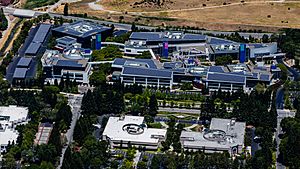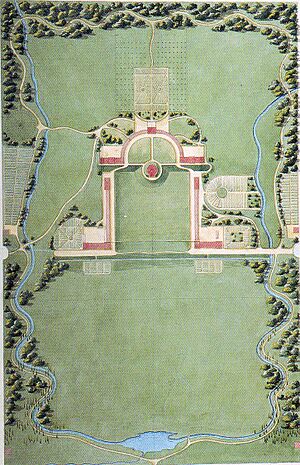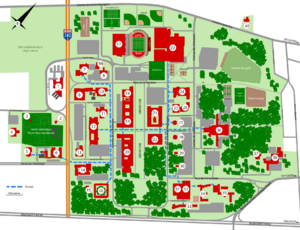Campus facts for kids
A campus is usually the land and buildings that belong to a college or university. This often includes libraries, classrooms (called lecture halls), student centers, and places for students to live and eat, like residence halls and dining halls.
Sometimes, the word "campus" is also used for a group of buildings and land owned by a company, especially in the technology world. Famous examples include Bell Labs, the Googleplex, and Apple Park.
Contents
What Does "Campus" Mean?
The word "campus" comes from the Latin word campus, which means "field." It was first used for schools at Princeton University in 1774. At Princeton, it meant a big open space on the school grounds. Later, by the end of the 1800s, it was used by many US colleges to mean all the school grounds. In the 1900s, it started to include the buildings too.
How Campuses Started
The idea of a campus began with old universities in Europe during the Middle Ages. Students and teachers lived and worked together in a closed-off area, like a cloister. This idea that the setting was important for learning later came to America. Early schools in the American colonies were built like the colleges in Scotland and England.
Over time, the American campus changed from the old European style. Early American colleges had their own unique designs. Some were just one building, like Princeton's first campus. Others were arranged like a cloister but with an American twist, like Harvard's. Campus designs and buildings across the country have changed with new ideas and styles over the years. Most campuses today show a mix of different old and new styles.
In 1922, an expert named Patrick Abercrombie talked about how American campuses were different from the colleges in places like Oxford and Cambridge in Britain. He said that in America, the school buildings were often spread out in a park-like area among trees. In contrast, British colleges often had buildings around a formal, enclosed grassy area.
The first true "campus universities" in Britain, where buildings were spread out in a park-like setting, were built after 1945. For example, the University of Reading moved to its Whiteknights campus in 1947.
Different Uses of the Word "Campus"
Company Campuses

In the early 1990s, companies started using the word "campus" for their office buildings. This happened when Apple built its Infinite Loop campus, which was used for research and development. The Microsoft Campus in Redmond, Washington, is another example, even though it was built earlier in the 1980s. Today, even hospitals and airports sometimes use the word "campus" to describe their large areas.
University Campuses Around the World

The word campus is also used for universities in Europe. However, some very old universities there, like those in Bologna, Padua, Oxford, and Cambridge, are different. They don't have big, park-like lawns with buildings spread out. Instead, their many buildings are often located throughout a city where the university is a big part of the community.
World Heritage Campuses
Some university campuses or parts of them are so special that UNESCO has named them World Heritage Sites. This means they are important to everyone in the world. Here are a few examples:
- Botanical Garden, University of Padua, Italy – This is the world's oldest botanical garden, recognized in 1997.
- Central University City Campus of the Universidad Nacional Autónoma de México, Mexico – This campus was recognized in 2007.
- Durham Castle and Cathedral, UK – This includes University College, Durham (Durham Castle) and the old part of Durham University around Palace Green. It was recognized in 1986.
- Medina of Fez, Morocco – This includes the University of al-Qarawiyyin, recognized in 1981.
- Monticello and the University of Virginia in Charlottesville, USA – This includes the Rotunda and the old part of the university around the Lawn. It was recognized in 1987.
- University City of Caracas, Venezuela – This is the main campus of the Central University of Venezuela, recognized in 2000.
- University of Alcalá de Henares, Spain – This was the world's first planned university city, recognized in 1998.
- University of Coimbra, Portugal – This university was recognized in 2013.
See also
 In Spanish: Campus para niños
In Spanish: Campus para niños
- Campus university
- Satellite campus



